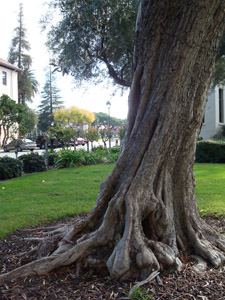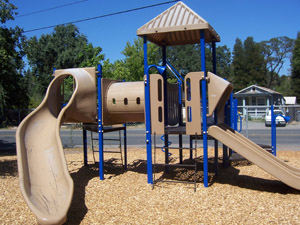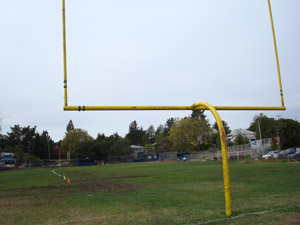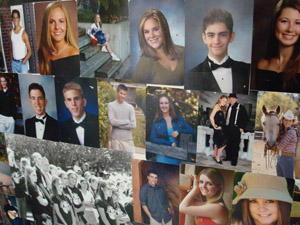 During my visit to Santa Clara University, I had a conversation with one of my former Psychology professors that gave me a new understanding of Reschool Yourself. It helped me articulate why it’s important to revisit my schools, and what I’m taking from doing so.
During my visit to Santa Clara University, I had a conversation with one of my former Psychology professors that gave me a new understanding of Reschool Yourself. It helped me articulate why it’s important to revisit my schools, and what I’m taking from doing so.
As an SCU student, I had Dr. Jerry Burger as a professor, academic advisor, and supervisor for my thesis research. At the time, I didn’t realize that he was already doing extensive research on a topic closely connected with Reschool Yourself: making a pilgrimage home.
For more than a decade, Dr. Burger has surveyed and interviewed hundreds of people who journeyed back to the places they grew up: schools, playgrounds, local stores, and most importantly, their childhood homes.
“Their quest,” he writes, “was to connect with something only the place could provide.” He adds that he was surprised by “the large number of people who knocked on the door of a former home and asked the current owners if they could look around. Without exception, the visitors were invited inside.”
Although people tend to think that they’re the only ones who make this kind of journey, there are millions who have. Here’s how Burger describes the phenomenon:
They return to see the buildings and physical features that made up the landscape of their childhoods. Many make the trip alone, but quite a few bring along family members and loved ones. Some plan their trips for years, while others act on a whim….For some people the trip was joyful, for others painful. A few were uncertain if the visit helped, but nearly all were glad they made the trip. Most wanted to go back someday. But others said they had accomplished all they needed in one trip.
 Throughout my life, I have made visits like these instinctively, specifically visiting my old schools again and again. From the time I was a teenager, I regularly felt compelled to take a walk around my elementary school and journal there, or simply remember what had happened in each location. In college, I’d stop by my high school and reminisce about what I’d experienced there. This fall, just being in the spaces at the schools has triggered memories of all kinds that I’d long forgotten. I’ve also looked through old class photos, which has reminded me that certain people even existed. Even if I hadn’t thought about these events and classmates in many years, some still carried an emotional charge that may have unconsciously affected me.
Throughout my life, I have made visits like these instinctively, specifically visiting my old schools again and again. From the time I was a teenager, I regularly felt compelled to take a walk around my elementary school and journal there, or simply remember what had happened in each location. In college, I’d stop by my high school and reminisce about what I’d experienced there. This fall, just being in the spaces at the schools has triggered memories of all kinds that I’d long forgotten. I’ve also looked through old class photos, which has reminded me that certain people even existed. Even if I hadn’t thought about these events and classmates in many years, some still carried an emotional charge that may have unconsciously affected me.
There’s a scene at the end of one of my favorite movies, Before Sunrise, that captures the memory-triggering power that spaces can hold. (Don’t worry, I won’t spoil anything.) The movie is about a young man and woman who meet on a train and walk around Vienna together all night. Once they’ve left, the camera cuts to the places where they had once laughed and talked, lingering on each one: a cafe, a lonely side street, a grassy park. Though each space is now empty, it triggers the same nostalgia in the viewer that the characters are feeling. I’ve been fascinated by this idea as I’ve revisited my old school spaces: that a single classroom or hallway can hold so many different memories for so many people.
 So what do you do with these memories once they’ve surfaced? What I’ve done with mine reminds me of Buddhist Pema Chodron’s instructions for meditation: “Touch the breath and let it go.” Over the last few months, I’ve been able to touch hundreds, perhaps thousands, of memories, and let them go.
So what do you do with these memories once they’ve surfaced? What I’ve done with mine reminds me of Buddhist Pema Chodron’s instructions for meditation: “Touch the breath and let it go.” Over the last few months, I’ve been able to touch hundreds, perhaps thousands, of memories, and let them go.
Sometimes I did this consciously, like when I thought about awkward or painful situations from my childhood. It’s comforting to chart my progress and realize that if the same thing were to happen today, it wouldn’t bother me much.
Sometimes the letting go was automatic, like breathing itself, and I felt lighter once I’d remembered something, acknowledged it, and moved on. As a sentimental person who tends to cling to the past, I’ve felt cleansed by this process.
 I think of this practice as a “memory walk.” It can be not only a physical stroll through an old stomping ground, but also one in your mind; I’ve imagined myself walking to work in Barcelona many times, and I feel as if I were really there. You can also take a memory walk by paging through photo albums and journals, or watching home videos. I’ve been doing this all fall and have finally been able to get rid of some of the keepsakes I’ve been hanging onto. I’ve found that the Buddhists are right: A healthy detachment is the way to happiness. When I’m not surrounded by mementos, I no longer feel the need to revisit the past compulsively, without quite knowing why.
I think of this practice as a “memory walk.” It can be not only a physical stroll through an old stomping ground, but also one in your mind; I’ve imagined myself walking to work in Barcelona many times, and I feel as if I were really there. You can also take a memory walk by paging through photo albums and journals, or watching home videos. I’ve been doing this all fall and have finally been able to get rid of some of the keepsakes I’ve been hanging onto. I’ve found that the Buddhists are right: A healthy detachment is the way to happiness. When I’m not surrounded by mementos, I no longer feel the need to revisit the past compulsively, without quite knowing why.
In separate posts, I’ll share photos from my memory walk around the SCU campus and my old apartment complex. Over several hours on a Saturday, I visited every place that had significance for me, as well as did the activities and ate the foods that I used to. Afterward, though mentally and exhausted, I felt much more peaceful than before I’d started.
If you feel some unfinished business with a certain place, even if you’re not sure why, a memory walk might help you put it to rest.
*************************************************************************************************************************
Your Two Cents: Leave a Comment!
What kinds of memory walks have you done, and what has resulted from them?
A few years ago, my dad lay dying in the same Connecticut hospital where I had been born. My sister and I (she from North Carolina and I from Mississippi) traveled there to spend his last two weeks together and to support my mom. While there, my sister and I took a memory walk to the house, just a few blocks from the hospital, that my parents were renting when I was born. Oblivious to the late November chill, we felt compelled to continue our walk, past the apartment where I had spent my early childhood, past the elementary school, the church, the pond where we caught turtles with my dad….Every step unleashed a flood of memories, some hilarious, others poignant, all now bittersweet as we took this journey for what we knew would be the last time. Mom was selling the house that had been in our family for decades and moving in with my sister’s family in North Carolina, so there would be no home to return to. We were reconnecting with our past only to say our final goodbyes. But there was something profoundly satisfying about our memory walk nonetheless, the blessing of a last, lingering embrace with not only the person but also the places that had shaped our lives.
Beautiful story; I can imagine everything vividly. You remind me that walking or simply reminiscing with someone who shares your experience can be even more powerful than doing so by yourself. A sibling or childhood friend may remember different things than you do, and the spaces are likely as meaningful to them as they are to you.
Many of us have also introduced our friends, children, or partners to places that hold significance for us. For example, I took Darren on a midnight walk around SCU even before my reschooling began. I think it’s partially so our loved ones can visualize the settings for our stories, and also because it’s somehow important to us that they know the places we came from.
This rings a bell, without a doubt! I recently returned to Paris, where I studied abroad years ago, and without planning to I found myself revisiting all of the old familiar places — my old apartment building, the school where I studied, my favorite bakeries and cafes. It was almost an unconscious drive to go back and see all of these places, and somehow it made me happy just to be there again, thinking about what has and hasn’t changed since I was last there…
I did the same thing when I visited Barcelona and Salamanca, where I’d lived a few years before. Even though I didn’t consciously remember where my old hangouts were located, my feet seemed to take me instinctively to the places that had significance for me.
Pingback: Reschooling Tool #19: Touch the Past and Let it Go - Reschool Yourself